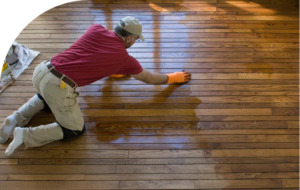Sacramento Cabinet Refacing is a great way to transform your space without the cost and disruption of a complete remodel. But before you begin, there are several steps to consider.
Thoroughly clean and sand the cabinet boxes to prepare them for the new materials. Ensure the boxes are properly ventilated to avoid excessive moisture, which can cause problems like warping and wood expansion.

Removing the Old Cabinets
Cabinet refacing is the fastest, most affordable way to upgrade your kitchen. The process uses the existing cabinets but adds new doors and drawer fronts, then applies a matching veneer over the cabinet boxes and face frames for a dramatic transformation. This saves time and money compared to a full cabinet replacement, and also reduces waste.
The first step is to remove the old cabinet doors and drawer fronts. Once they’re removed, carefully take measurements of the cabinet boxes and doors to ensure the new components will fit correctly. Next, the cabinet boxes are cleaned, lightly sanded, and prepped for the new veneer or laminate. This step is vital for ensuring the new materials adhere to the cabinet boxes securely and last longer.
Finally, the existing hinges are replaced, and the interior of the cabinets is painted. It’s a good idea to close up any holes in the wall where utility pipes or gas lines were previously installed, as well. This will prevent water damage or problems with your gas or electrical service if the old cabinets are ever reinstalled in a different room.
Using a stud finder, locate the structural studs behind your cabinet boxes. It’s important to pry against the studs instead of the drywall to avoid damaging your walls. If necessary, use a hammer and wedge a pry bar between the cabinet and wall to loosen the cabinet from the wall before gently pulling it free. Repeat the process for each wall cabinet, then move on to the base cabinets.
Preparing the Surfaces
Cabinet refacing involves applying a high-quality veneer to the existing cabinet box frames, giving you a completely new look and transforming your entire kitchen. Before the installer can begin working on the cabinets, however, they need to thoroughly clean and prepare the surfaces.
This step ensures that the refacing materials will adhere properly and will provide a long-lasting finish. To do this, the first thing to do is remove all the cabinet doors and drawer fronts and set them aside in a safe place. Next, remove the old cabinet hardware, such as knobs, handles, and hinges. Then, wipe down the inside and outside of the cabinet boxes with a mild cleaner and degreaser to remove any grease or dirt that may interfere with the adhesion of the refacing material.
It’s also a good idea to clear out the contents of your cabinets and cupboards. This allows for easier access and protects your belongings from dust and debris during the refacing process. In addition, it’s a good idea to move any movable furniture in the room, such as bar stools or small tables. Lastly, make sure that there is a clear path from the entrance to the work area to help the contractor operate in your space more efficiently and prevent any potential tripping hazards.
Once the surfaces are dry, they should be sanded down lightly with a light grit sandpaper to create a smooth surface that will accept paint well. Any dents or deep scratches can be filled in with wood putty or auto body filler and then sanded again to remove any rough edges. After this, you can apply an adhesion-promoting primer.
Applying the Veneer
Cabinet refacing involves applying strips of wood or other material to the face frames of the cabinets. These strips are applied to mimic the existing vertical members of the face frame (“stiles”) and horizontal members (rails). It is often a good idea to apply some sort of finish to these surfaces after applying the veneer to make sure they will be water-resistant, durable, and stain-resistant.
Use a brush or a roller to apply a thin coat of adhesive to the surface you want to reface. Then place the piece of veneer down and press firmly to ensure it adheres. If you are worried about getting glue on the door or drawer front, work ahead where the two cabinets meet so you don’t accidentally get the adhesive on them.
Once the adhesive has dried a little bit, peel back the paper backing on the veneer and then begin working with it. Start on the vertical front pieces of the cabinet and work your way around the cabinet box. You may have to trim the corners where the vertical and horizontal front cabinet veneer pieces meet with a sharp utility knife.
Be careful not to cut too much of the veneer away from your final size. Leaving too much extra can result in having to trim it off later when you are trying to apply it to the cabinet end panels. For the cabinet end panels, measure the height and width of the panel and cut your veneer to that size. Then be sure to leave it about an inch oversized for the tall dimension so you can trim it to fit. This will save you a lot of time down the road.
Installing the New Doors and Drawer Fronts
Unlike a complete cabinet replacement, where cabinets are replaced entirely, refacing leaves the existing cabinet boxes intact. A layer of wood veneer or laminate is applied to the cabinet box faces and exposed sides, creating a fresh new look without the cost and time commitment of a full remodel.
During this step, the new cabinet doors are installed and aligned for a flawless fit. The door frame is also cleaned to remove any dirt or residue that could hinder proper adhesion. The face frames are then covered with a layer of veneer, which is carefully matched to the cabinet doors and drawer fronts in style and color for a uniform appearance. New hinges are installed for a smooth operation, and the drawer fronts are hung and attached using pre-drilled hinge holes.
In addition to enhancing the visual appeal of your kitchen, cabinet refacing is an environmentally conscious choice. The vast majority of household waste consists of furniture and cabinetry, with over 9 million tons of wood, metal, glass, fabric, leather, and foam going to landfills every year. By reusing the existing cabinet boxes and adding new hardware, refacing reduces waste and contributes to a more sustainable future.
When determining the size of your cabinet doors, it is important to choose a material that is 3mm smaller than your opening. This allows the cabinet door to open fully and prevents any gaps. Luckily, the experienced team is an expert at this process and can help you make the right decision to ensure a seamless finish.
During the initial consultation and measurements, your professional will evaluate your current cabinetry and discuss your options. They will also advise on any additional services you may wish to consider, such as new drawer fronts or upgrading your hardware.
Installing New Hardware
Whether you opt to install sleek modern pulls or classic and traditional knobs, new hardware adds the finishing touch to your beautiful kitchen. It is important to thoroughly clean the surfaces and sand them before installing the new hardware to ensure proper adhesion. It’s also important to regularly check the surfaces for signs of wear and tear and to re-tighten any loose screws as needed.
Kitchen cabinet refacing breathes new life into your home’s interior while saving you significant time and money compared to a full remodel. It’s ideal for homeowners who like their layout but need a fresher, more updated appearance.
It’s best suited for cabinets that are structurally sound, in good condition, and free from damage. Unlike painting, which has moderate durability, refacing involves adding entirely new surfaces that offer high-performance longevity.
This step-by-step guide will help you prepare for a successful cabinet refacing project. First, you’ll need to remove the old doors and drawer fronts using a screwdriver. You’ll then need to detach the cabinet hinges and sand down rough patches to create a smooth surface for the refacing materials.
Once the cabinets are cleaned and sanded, they should be primed to allow for a strong bond with the refacing material. Once the primer has dried, you’ll need to apply a coat of urethane to help protect your cabinets from future scratches and stains.
Cabinet refacing offers endless design possibilities to fit any vision. Whether you prefer a minimalist approach with laminates or the warmth and elegance of real wood, refacing will provide an instant transformation without the time and expense of a complete kitchen remodel. Moreover, refacing is eco-friendly and helps prevent MDF cabinets (which contain hazardous chemicals) from ending up in landfills.








